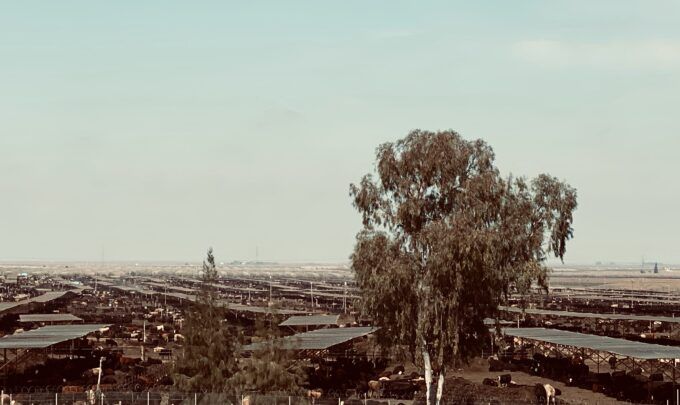
California Aqueduct. Photo: Jeffrey St. Clair.
The Kumeyaay People have lived in the region between the Pacific Coast of San Diego County, Baja California Norte. and Imperial Valley for 10,000 years. They hunted, fished, gathered and traded according to the seasons, from Bighorn sheep in the mountains to Mesquite beans in the desert, from abalone to yucca, rabbits to pinon nuts. They lived with this land for millennia before there was a Mexico or a United States. Even the desert provided for them abundantly.
But then, shrewd white men arrived and discovered that the soil of this desert was in fact a rich alluvial plain of Colorado River silt that could be cleared, ploughed, harrowed, irrigated, planted and made to grow profitable crops for export on the railroad. So, they bought a great deal of land, developed a small canal from the Colorado, sold land to other white men, who began the new form of gaining food – not by gathering the fruits of this rich desert, but by planting crops and gambling on markets.
Soon, the gamblers started a more ambitious canal, the All-American Canal. It blew out and flowed north into the Salton Sink for three years, creating the Salton Sea. It took the resources of Southern Pacific to stop the flow in 1907.
Farmers went on to develop the desert for more than a century, first creating Imperial County out of eastern San Diego County in 1907. In 1911, they created their most powerful institution, the Imperial Irrigation District. In 1922 they bargained in the 7-state Colorado River Compact for 3.1 million acre-feet of water out of California’s total share of 4.4 million acre-feet. An acre-foot of water equals 325,851 gallons or three-quarters of a football field covered in a foot of water.

Irrigation ditch, near Tule Lake, California. Photo: Jeffrey St. Clair.
Although Imperial Valley is the last stop in the US for the Colorado River, due to its early development of irrigation and the volume of water it wanted and created the irrigation system to get, and the legal doctrine of “Prior appropriation rights” (first in use, first in right), Imperial Valley receives more water than five states in the compact and almost as much as the whole state of Colorado.
Prior appropriation rights are not the only method of distribution of river water in the West. The first water right recorded on the Colorado River was given to the San Luis Peoples’ Ditch, in 1854, a community owned and operated irrigation canal in the San Luis Valley established under the Spanish (ultimately Arab) acequia irrigation system. The New Mexico Acequia Association protects this communal system of water distribution to this day in that state. Utah also has its own community irrigation tradition. I point this out because so many people, urban or rural, particularly in Southern California, think Imperial Valley is a normal, inevitable fact of human progress.
It isn’t. It’s not normal or inevitable that any California irrigation district should contract to provide 5 acre-feet of water to its members, about 500 farms owned by a few large, absentee farmers, in control of 3.1 million acre-feet of water from a catastrophically overdrawn river. A benchmark figure for irrigation in California is around 3 acre-feet for almond orchards or vineyards.

Harris feed lot, near Coalinga, California. Photo: Jeffrey St. Clair.
Today, the largest commodity in Imperial Valley is feedlot cattle, mostly for Holstein steers and heifers, provided by the California dairy industry, largest in the US. Next comes alfalfa, sold to California dairies, feedlots and horse ranches and exported to Asia and Arab countries. Alfalfa is in several ways a beneficial crop: its long roots loosen soil and fix nitrogen in the soil, which tends to improve rather than deplete soils. But the price is more than 6 acre-feet of water to irrigate it.
The feedlot Holstein steers and heifers in those temperatures need between 15-30 gallons a day depending on age and weight, (adapted from Nutrient Requirements of Beef Cattle: Eighth Revised Edition: Updated 2016). Last year the seven Imperial Valley feedlots reported feeding 460,000 head.
Imperial Valley, a desert in the southeast corner of California, hardly figures in the thoughts of urban Southern Californians. Their hectic lives do not foster any curiosity about the crisis of infrastructure, economics, law and politics that underlies their water and power supply. Mainstream Southern California media has pacified environmental concerns for decades and reassures them daily that new technologies to desalinate and recirculate wastewater will provide enough water if, as the usual academic advises, “we use it wisely.”
Whatever may be done, if anything is done about the Colorado River, will be decided by Power and Money, Southern Californians say.
This simple clarity is undimmed by thoughts of the Common Good or the Public Benefit. It is not per se political; in fact, it simply recognizes the brutal private Power and Money operating behind the array of public agencies and bought politicians against state and federal law and regulation.
But Lake Mead, behind Hoover Dam and its electric generators, is at 25-percent capacity. La Nina is still in place and the drought will continue, according to the National Oceanic and Atmospheric Administration (NOAA). Power and money will decide the winners and losers of Colorado River water next year and the decision will be sold as, somehow, beneficial to economic growth and the environment. But, that growth is not for everyone. Imperial, Tulare, and Fresno counties, each national agricultural powerhouses, are the three poorest per capita counties in California.

Irrigation agriculture in the Imperial Valley. Photo: Jeffrey St. Clair.
The Bureau of Reclamation has clearly adjudicated authority to decide apportionment of water in years of drought. Last summer BOR Commissioner Camille Touton gave the three lower river states, Arizona, Nevada and California, a month to come up with a plan for voluntary cutbacks. They didn’t and she didn’t use her authority to mandate cutbacks.
Touton began her political career in Nevada Sen. Harry Reid’s office. The top priority for the river of her boss, Department of Interior Secretary Deb Haaland, an enrolled member of the Laguna Pueblo, appears to be enforcement of the water rights of the 29 Native American tribes that have been promised since the 1922. The Assistant Secretary for Water and Science is Tanya Trujillo, a Washington resource bureaucracy attorney, who like Haaland, began her political career in New Mexico. Their careers were made by climbing the ladders of NGOs and public agencies and politics that feed on the river for the sake of grants and elite careers.
On the legislative side, Arizona Rep. Raul Grijalva, D-AZ, has been the chair of the House Natural Resources Committee. His letter to Secretary Haaland last summer began:
“Dear Secretary Haaland, As you know, climate change and unsustainable water use are bringing us close to a catastrophic collapse of the Colorado River System. Avoiding this disastrous outcome will require a major change in status quo management approaches and significant reductions in Colorado River water use by all Colorado River Basin states, including Upper Basin states. Toward that end, in the absence of voluntary water use reductions, I respectfully urge the Department to fully use its existing legal authorities to require an additional 2 to 4 million acre-feet in water conservation to protect the Colorado River System…”
But Grijalva will be removed from his position when Republicans take control of the House. The front runner for House speaker is Rep. Kevin McCarthy, R-Bakersfield CA, who is sure to be a powerful advocate for California agribusiness getting every drop of Colorado River water it believes it is owed. Haaland and Touton caved under pressure when Pelosi and Grijalva were in power. What chance has the river, despite Interior’s latest threat last month to impose cuts Grijalva suggested with McCarthy, a split Senate and another Californian, Vice President Kamala Harris. breaking tie votes?
For these reasons, the rotten politics behind the lower-states’ division of river’s water is a scandal concealed by superior PR. Nevada and Arizona will get large cuts next year, but California is likely to get much less because of it political clout, including an agreement with Arizona made 50 years ago:
“’…in 1968 when Arizona went to Congress to get federal funding to build the central Arizona project, California took the legislation hostage and would only allow them to get that federal funding if they agreed to put a clause in that would have Arizona take all of California’s cuts,’ says John Ensminger from the Southern Nevada Water Authority.” By: Joe Moeller , KTNV, Aug 17, 2022

Irrigators’ road signs along I-5 demanding more water and more dams. Photo: Jeffrey St. Clair.
Meanwhile, demand for water in the Imperial Valley is growing, irrigation efficiencies cannot keep up with it, the river is in severe decline, the Salton Sea continues to shrink, yet IID’s water rights remain nearly divine in its service area as the river water itself gets saltier by the year.
“In California’s Imperial Valley, which grows about 80 percent of the nation’s winter vegetables, irrigating with Colorado River water has caused some fields to become so salty that they have been abandoned.,, During the 1960s, so much salt flowed into the Colorado River from U.S. farms that Mexico, at the downstream end, could no longer use it for irrigation; a solution was finally negotiated in the 1970s requiring major reductions in the river’s saltiness. Laws were passed, and an array of federal program were created that gave farmers incentives to improve their irrigation methods.” –Jodi Peterson, KYNF, Dec. 22, 2020.
In coming months California will make gestures for the media, like the offer the state made to cut 400,000 acre-feet next year, with IID offering to cut 250,000 acre-feet in the coming season. But in the lower graphs of the story, the IID spokesman added the condition that the federal government would have to help it deal with the Salton Sea, a huge sump for agricultural runoff from Imperial County, which has begun to shrink in recent years, due partly to improved irrigation methods and partly to global warming. The shrinking has left several hundred yards of a shoreline of toxic dusts. Intense windstorms pick up dust and pollute the air as far north as tony Palm Springs. Plans to mine the bottom for lithium are going forward, but a recent proposals to pipe in seawater from the Gulf of California failed to get county approval.
Taxpayers, through the mechanism of the Farm Bill (a new one coming next year) and other spending bills aimed at drought-affected farmers, will pick up much of the losses a few large farmers will sustain, through subsidized crop insurance and payments to fallow land. The grandchildren of the row-crop gamblers of yesteryear are playing with house money these days. But you can’t fallow a date grove or a citrus or almond orchard, and crop insurance doesn’t pay workers not to work in fields that aren’t planted.
The people that will be hardest hit are, as always, the local farmworkers, who live in Imperial Valley or across the line, breathe lousy air, care for their asthmatic children and elders, drink polluted water in punishing heat, and will lose jobs that bureaucrats call “unskilled labor.”








